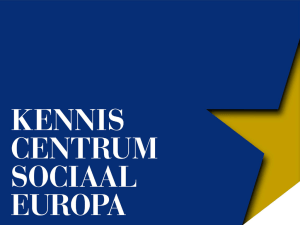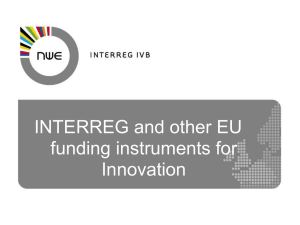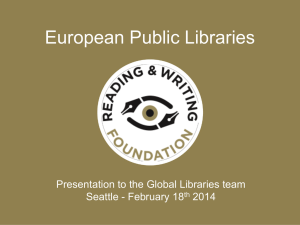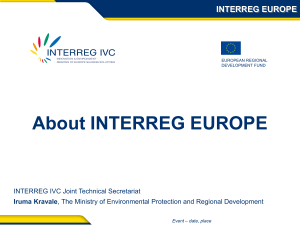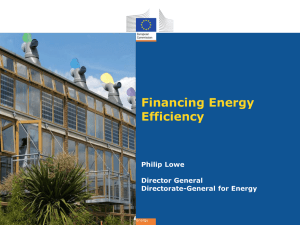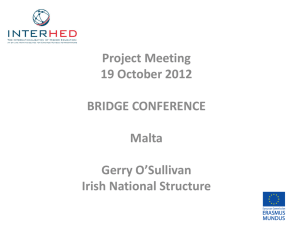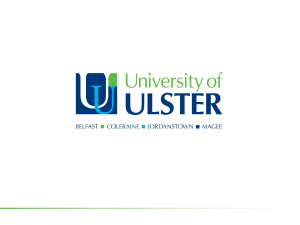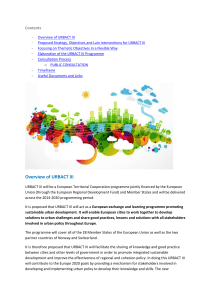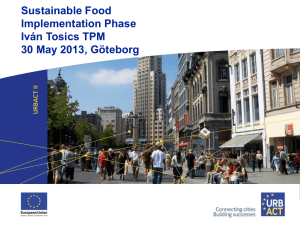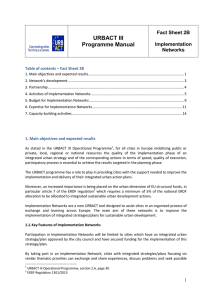Opportunities from other EU Funding Programmes
advertisement
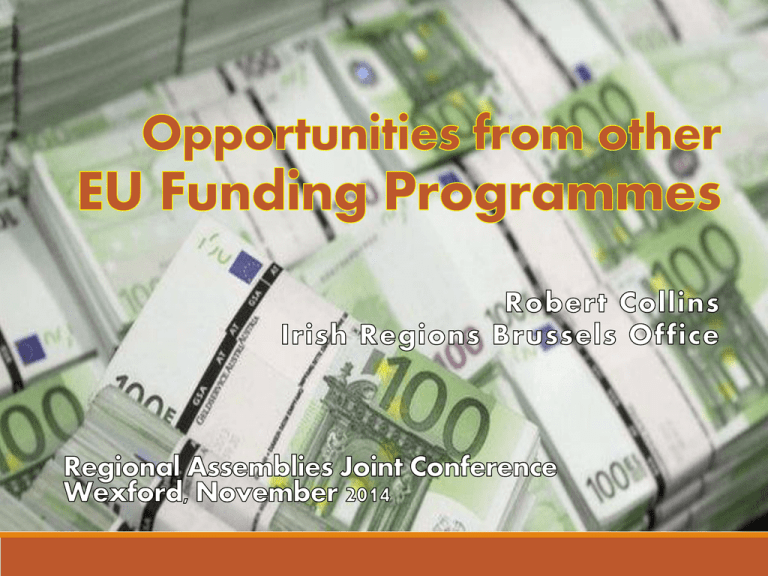
Introduction Context - Policy Context - Budgetary Context Nature of EU Programmes and how they operate Selection of Programmes that provide best opportunities Targets and some Next Steps Policy Context Policy Context – some key messages: EU Programmes do not operate in isolation Funding follows Policy - programmes exist to achieve EU priorities Need a knowledge of the policy to use the Programmes Don’t chase the money – need to align your objectives with policy Europe 2020 Strategy EU Strategy for Smart, Sustainable and Inclusive Growth Key Policy Framework for the 2014-2020 programme period: What you need to know – what it is Europe 2020 Strategy Targets to be achieved by the EU by 2020: Employment Increase employment to 75% of 20-64 year-olds Innovation Increase investment in R&D to 3% EU GDP Climate/Energy - Reduce greenhouse gas emissions by 20% - Increase energy from renewables by 20% - Increase in energy efficiency by 20% Education Poverty - Reduce rates of early school leaving below 10% - Increase to 40% those completing 3rd level education Lift at least 20 million people out of poverty Flagship Initiatives (E2020) Budgetary Context EU Budget Total EU Budget is €960 billion (2014-2020) Most is pre-allocated to traditional budget lines – CAP, ESIFs Budget ‘in play’ about €100 billion (to compete for) National Objective National target is ‘juste retour’ (at least €12.5 billion) What is the strategy? Have we got the capacity? Where do local authorities and regional assemblies fit in this? Additional EU Resources European Investment Bank – Financial Instruments European Commission – new Investment Package (€300 billion) Direct Management Programmes Direct Management Shared Management Managed by the European Commission (usually) Devolved management to state, region or other entity No national allocations Allocations per Member State/region Calls for Proposals - annual call (usually) Competitive Bidding Process Multiannual Programme process, with a limited competitive element Strong Transnational requirement Programmes are national or regional National Contact Points to assist/advise Managing Authority manages and runs the programme Funds are largely independent – different criteria What will be a runner? Applications will need to demonstrate: Excellence – bid (quality and innovative), likely benefits Wider Applicability – can’t have just local relevance EU Added-Value – progress policy or improve policy implementation Potential to Deliver Results – long-term impact and viability Realistic and Measurable Approach – results-based approach Commitment to Disseminate Results and potential Transferability of Outcomes Programmes - overview European Territorial Cooperation (ETC) • • • • • INTERREG Cross-border/Transnational INTERREG Europe URBACT PEACE Innovative Urban Actions Horizon 2020 (Research and Innovation) • focus on Societal Challenges LIFE + (Environment) CoSME (Enterprise) Erasmus + (Education, Training, Sport) Creative Europe (Culture and Creativity) Europe for Citizens EaSI (Employment and Social) Connecting Europe Facility Civil Protection Asylum and Migration Fund Rights and Citizenship Consumer Programme Health for Growth ETC - INTERREG Europe INTERREG Europe - Pan-European programme – policy learning for local/regional authorities Replaces INTERREG IVC (2007-2013) INTERREG IVC – 26 projects with an Irish partner Budget 2014-2020: €359m First Call: April 2015 National Contact Point: S&E and BMW Regional Assemblies ETC - INTERREG Europe INTERREG Europe – 4 thematic objectives: • Strengthening research and innovation • Enhancing the competitiveness of SMEs • Supporting the shift towards a low-carbon economy in all sectors • Protecting the environment and promoting resource efficiency INTERREG Europe - 2 types of action: • Classic ‘interregional cooperation projects’ partnership approach; • New ‘policy learning platforms’ offering tailored advice and solution services to local or regional development organisations New Aspects – Closer link with ERDF and involvement of Managing Authorities, implementation of projects over 2 phases. ETC - URBACT III URBACT III - Pan-European exchange and learning programme to promote integrated sustainable urban development Replaces URBACT II (2007-2013) URBACT II – 8 projects with an Irish partner Budget 2014-2020: €79m First Call: Feb 2015 National Contact Point: tbc ETC - URBACT III URBACT III – 4 main objectives: • Capacity for Policy Delivery – Smart Sustainable and Inclusive Growth • Policy Design • Policy Implementation • Building and Sharing Knowledge URBACT III – 3 types of intervention • Transnational Exchange • Capacity Building and Capitalisation • Dissemination Local and Regional authorities – key target audience *Please note – includes Urban-Rural linkages URBAN – Innovative Actions NOT an ETC Programme - Innovative Urban Actions - new competitive fund for urban authorities to be managed by the European Commission Budget of €330m (from 2015) Objective will be to promote innovative and experimental demonstration projects, studies, pilot projects of EU interest in this field. Possible for all Thematic Priorities of Cohesion policy Possible establishment of an Urban Development Network Actions of up to €5 million (co-financing up to 80%). Projects should be no more than 3 year duration. Details of how this programme will operate and who will be eligible (urban areas – 50,000+) have yet to be agreed. Horizon 2020 Framework Programme for Research and Innovation (Budget: €70.2 billion) Horizon 2020 - 3 pillars: (1) Excellence in Science; (2) Creating industrial leadership and competitiveness (3) Tackling major Societal Challenges Horizon 2020 – key features: (a) SME-oriented approach (b) Broad definition of ‘Innovation’ - not just technology & research in isolation. This means: new uses for and combinations of existing technology. non-commercial applications (e.g. for better public services) new interaction with end users (incl general public) non-technological innovation Opportunities for local/regional authorities? Horizon 2020 - Societal Challenges Societal Challenges – Budget €29.7billion 1. Health, demographic change and well-being (€7.5bn) 2. Food security, sustainable agriculture and forestry, marine, maritime and inland water research and the bio-economy (€3.9bn) 3. Secure, clean and efficient energy (€6bn) 4. Smart, green and integrated transport (€6.3bn) 5. Climate action, environment, resource efficiency, raw materials (€3bn) 6. Inclusive, innovative and reflective societies (€1.3bn) 7. Secure societies, protecting freedom and security of Europe and its citizens (€1.7bn) Horizon 2020...local opportunities? ‘Societal Challenges’ present some opportunities: • Emphasis on multi-disciplinary collaboration... bring together resources and knowledge from across different fields, technologies & disciplines; • Innovation by and for the public sector has been identified as a requirement in order to drive up the performance of public services; • Fast-tracking deployment of new high-impact approaches to deal with challenges. Local Authorities some scope to: partner with innovative enterprises to help to bridge the gap between research and market uptake? provide real world setting for innovation-related activities such as prototyping, testing, piloting, demonstration or market replication develop ‘’innovation ecosystems’’... bringing key actors together ...create synergies, increase capacities and build critical mass. LIFE+ Programme EU Programme for Environment and Climate Change: Key objectives: Enhance implementation of policy, improve Member State practice, act as platform for accelerating change (e.g. via exchange) 2 Sub-programmes: (1) Environment – Resource Efficiency; Nature and Biodiversity; Compliance (2) Climate Action – Mitigation; Adaptation and Resilience; Governance 2 Types of Project: Traditional – stand alone project Integrated Project – large scale, implementation strategies/action plans Local/Regional Dimension - emphasis on better governance Budget: €3.46 billion – Environment (€2.6b); Climate Action (€864m) LIFE+ Programme Indicative National Allocations – 2014-2017 (Environment sub-programme) after that ‘merit based’. At least 3 Integrated Projects per Member State. Co-financing Rate – 60% (2014-2017); 75% (priorities under Birds and Habitats Directive) In Ireland: Irish allocations 2014-2017 - €11.5m (environment projects) National Contact Point – DECLG - more proactive approach DECLG prepared an Information Note on the Programme More active during bid preparation – information day, concept notes, application writing workshop. Annual Call - May Deadline - October COSME Programme Programme for Competitiveness of Enterprises and SMEs Focus: promoting more dynamic and internationally competitive SMEs Proposed budget: €2.3 billion (2014-2020) 4 themes (% of budget): Facilitate access to finance for SMEs and entrepreneurs (60%) Improving framework conditions – reducing burdens (11.5%) SME internationalisation and market access (21.5%) Promoting entreprenship – skills, culture for dynamic business creation & growth (exchanges with a focus on women and young businesses) (3%) Open to all types of SME COSME Programme Actions to improve SME access to finance (€1.4 billion) Equity Facility for SMEs in expansion phase (+/- €500 million): Venture Capital (VC) with focus on firms with greatest potential Loan Guarantee Facility for SME growth & RDI (+/- €600 million): Guarantees for loans to SMEs up to €150,000. These funds were seen as successful in 2007-13 - €1.1 billion levered €23 billion in loans and €2.3 billion in VC for SMEs. Operate through banks and other intermediaries. Promotion of Entrepreneurship (€88.6M) • Developing entrepreneurial skills and culture - especially among new entrepreneurs, young people /women – targeted sector-specific initiatives. • ‘Erasmus for Entrepreneurs’ - transnational exchange scheme. • Awareness of opportunities for LEOs? Erasmus + ERASMUS+ Programme – Budget: €14.7 billion Integrating EU support actions for: Education & Training Youth issues Sport • Key Action 1: Learning Mobility of individuals (66% budget) (Mobility of: Higher education students; Staff and Youth, including volunteering and youth exchanges) • Key Action 2: Innovation & exchange of good practices (26% budget) • Key Action 3: Support for policy reform (5% budget) What scope for integration of ET&Y issues into local & regional development??? Erasmus+ (Sport) New dedicated budget line for the European dimension of sport. (€264.6M) Sport measure will focus on: strengthening good governance and the EU knowledge base for sport; promoting health-enhancing physical activity; (*) exploiting the potential of sport to foster social inclusion; (*) promoting dual careers through education and training of athletes; and tackling threats such as doping, match fixing, violence, and racism. Activities include: transnational collaborative projects; (*) strengthening of the evidence base for policy making; capacity building; dialogue with relevant European stakeholders. (*) potential for local authorities? . Creative Europe Programme for the Audiovisual, Cultural and Creative Sectors – €1.46 billion 2 Sub-programmes: MEDIA programme (audio-visual sector) - €800m CULTURE programme (including heritage) - €450m Guarantee Fund (for cultural operators) - €121m (to realise bank loans totaling €750m) Key Priorities (emphasis on growth/employment): Training and development support (film, TV, video games, etc) Distribution of work and reaching new markets Innovative audience-building, cultural/media literacy, film festivals Transnational cooperation, work across borders, gain skills and knowledge New business models…artistic and cultural networks Contacts CULTURE Programme - The Arts Council (Dublin) MEDIA Programme – MEDIA office (Dublin) and MEDIA Office (Galway) Europe for Citizens Europe for Citizens Programme 2014-2020 – Budget €186m Objectives to: contribute to citizens' understanding of the EU, its history and diversity; foster European citizenship and civic and democratic participation at EU level; raise awareness of remembrance, common history and values; encourage democratic participation of citizens, develop citizens' understanding of the EU policy making-process and promote opportunities for societal and intercultural engagement and volunteering at EU level Support for: • European remembrance – debates and cooperation events • Democratic engagement/civic participation - Town Twinning, Networks of towns, Civil society projects • Operating grants – EU-wide organisations promoting shared objectives Contact Point: Ireland – Institute of Public Administration Employment and Social Innovation (EaSI) EaSI – innovative in…promoting employment, social inclusion and labour mobility. Budget €919m 3 Axes: Microfinance & Social Entrepreneurship (MF/SE): (€193M) ◦ EIB financial support and risk-sharing loan guarantees (<€25,000) for setup/growth of micro-and social enterprises by target groups with difficulties accessing credit (e.g. unemployed, ethnic minorities, disabled...). [also PROGRESS Microfinance until 2016] ◦ Small-scale ‘social innovation & experimentation’ test projects (ESF up-scaling?). PROGRESS: modernising employment & social solidarity policy through analysis, learning and developmental actions (e.g. improving working conditions…equality in workplace…). EURES Employment Services: (transnational matching job-seekers with offers) Taking Opportunities Are these Programmes seen as Opportunities or as ‘too much trouble’? We have a poor track record = legacy of low awareness and preparedness – need to be realistic as to what can be achieved with resources available How will National objective be realised? Government Departments can’t/won’t do the applications!! If Local Government wants to compete what is required? Address low awareness and reduce the ‘risk’ of involvement; Adopt a Strategic Approach – Identify Priorities Work towards Targets and Goals? Regional Targets? Eastern and Northern and Southern Midlands Western POPULATION CAP (Pillar I) CAP (Pillar II) LEADER 2,200,000 €55m 800,000 €43m IRELAND 1,500,000 4,500,000 €55m €8,505m €2,037m €153m EMFF €148m ERDF ESF (+EYI) €208m €275m €121m €101m €128m €186m €457m €562m ETC €67.7m €86m €38.3m €192m Other EU €201m €74m €135m €410m Predominantly based on population (except LEADER) projection ETC – this includes all relevant INTERREG A, B and C programmes, with regional differentiation factored in. This also includes URBACT and Innovative Urban Actions. Other EU – only includes those budget lines that have a direct relevance of LRAs. Only includes ‘Societal Challenges’ of Horizion 2020, does not include the Education measures in ERASMUS +, for example. (H2020, Erasmus+, LIFE+, COSME, Creative Europe, Europe for Citizens, EASI) Basic Requirements Need a more Strategic Approach • identify local/regional prioritise, match these with EU objectives; • need to evaluate if an opportunity is worth pursuing Develop Capacity (and culture) and establish systems to compete • • • • • understanding policy context and programme requirements; monitoring funding calls - preparation and coordination of bids; financial management and compliance with programme requirements; resource availability – match funding (but not necessarily hard cash); culture of working in (international) partnerships, reporting and dissemination. Learn from others - existing good practice and experience (LAs and Reg. Authorities) Use Resources available to help • National Contact Points for EU Programmes • Irish Regions Brussels Office Thank you for your attention Robert Collins Head of Office – Irish Regions Brussels Office Tel: +32-2-233 1122 GSM: +32-498-120821 Email: robert.collins@iro.ie
